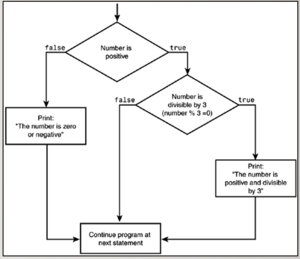Difference between revisions of "Tutorial12: Shell Scripting - Part 2"
(→Additional Logic Statements) |
(→Additional Logic Statements) |
||
| Line 53: | Line 53: | ||
Example: | Example: | ||
| − | <span style="font-family:courier;">num1=5<br>num2=10<br>if test $num1 –lt $num2<br>then<br> echo “Less Than”<br>else<br>echo “Greater Than or Equal to”<br>fi</span> | + | <span style="font-family:courier;">num1=5<br>num2=10<br>if test $num1 –lt $num2<br>then<br> echo “Less Than”<br>else<br>echo “Greater Than or Equal to”<br>fi</span><br><br> |
| + | |||
| + | [[Image:if-else.png|thumb|right|300px|Example of how an '''if-else''' statement works.]]'''if-elif-else Statements�''' | ||
| + | |||
| + | If the test condition returns a TRUE value, then the Linux Commands between then and else statements are executed. � | ||
| + | If the test returns a FALSE value, then a new condition is tested, and action is taken if the result is TRUE . Eventually, an action will be taken when the final test condition is FALSE� | ||
| + | |||
| + | Example:�� | ||
| + | |||
| + | <span style="font-family:courier;">num1=5<br>num2=10<br>if test $num1 –lt $num2<br>then echo “Less Than”<br>elif test $num1 –gt $num2<br>then<br> echo “Greater Than”<br>else echo “Equal to”<br>fi</span><br><br> | ||
===Additional Loop Statements=== | ===Additional Loop Statements=== | ||
Revision as of 08:09, 27 July 2020
Contents
ADDITIONAL SHELL SCRIPTING
Main Objectives of this Practice Tutorial
- Learn about additional logic control-flow statements if-else and if-elif-else
- Learn additional uses of the for loop control-flow statement.
- Learn the purpose of command substitution and how it can be used with control-flow statements
- List and explain the purpose of several start-up files
Tutorial Reference Material
| Course Notes |
Linux Command/Shortcut Reference |
YouTube Videos | ||
| Course Notes:
|
Additional Control Flow Statements | Startup Files
|
Brauer Instructional Videos: | |
KEY CONCEPTS
Additional Logic Statements
If the test condition returns a TRUE value, then the Linux Commands between
then and else statements are executed.
If the test returns a FALSE value, then the the Linux Commands between
the else and fi statements are executed.
Example:
num1=5
num2=10
if test $num1 –lt $num2
then
echo “Less Than”
else
echo “Greater Than or Equal to”
fi
If the test condition returns a TRUE value, then the Linux Commands between then and else statements are executed. � If the test returns a FALSE value, then a new condition is tested, and action is taken if the result is TRUE . Eventually, an action will be taken when the final test condition is FALSE�
Example:��
num1=5
num2=10
if test $num1 –lt $num2
then echo “Less Than”
elif test $num1 –gt $num2
then
echo “Greater Than”
else echo “Equal to”
fi
Additional Loop Statements
x
Using Startup Files
x
INVESTIGATION 1: ADDITIONAL LOGIC STATEMENTS
In this section, you will learn how to ...
Perform the Following Steps:
- x
In the next investigation, you will ...
INVESTIGATION 2: ADDITIONAL LOOPING STATEMENTS
In this section, you will learn how to ...
Perform the Following Steps:
- x
In the next investigation, you will ...
INVESTIGATION 3: USING STARTUP FILES
In this section, you will learn how to ...
Perform the Following Steps:
- x
LINUX PRACTICE QUESTIONS
The purpose of this section is to obtain extra practice to help with quizzes, your midterm, and your final exam.
Here is a link to the MS Word Document of ALL of the questions displayed below but with extra room to answer on the document to simulate a quiz:
https://ict.senecacollege.ca/~murray.saul/uli101/uli101_week12_practice.docx
Your instructor may take-up these questions during class. It is up to the student to attend classes in order to obtain the answers to the following questions. Your instructor will NOT provide these answers in any other form (eg. e-mail, etc).
Review Questions:
- x
- x
- x
- x
- x
- x
- x
- x
